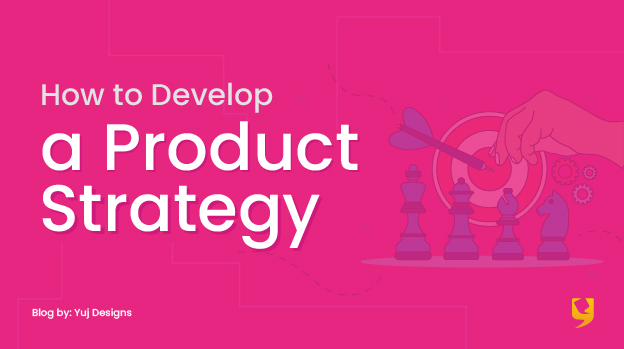
A Chinese proverb says, “When the wind blows, some people build walls, others build windmills.” The proverb reflects the different strategies people apply under extreme circumstances. Strategy is necessary in every business since it determines all the steps essential to achieve success.
Products that do not consider users and their problems, solve problems that do not exist. Incorrect solutions can be fixed, but solutions for non-existent problems cannot be found. For businesses to avoid this scenario, a product strategy is a must.
What is Product Strategy?
Product strategy is the vision of where the product will reach, i.e. it is the planning of the steps to make sure the product reaches the desired market. Such product strategy helps in deciding the fundamental components of a product and accurate direction for the product as well as it helps in targeting the product to the appropriate segment.
In short, product strategy gives details of who are your customers, how your product fits in the market, and how it will attain your business objectives. The product strategy plays a significant role in focusing on what will have the most considerable impact on your business and customers. Thus, product strategy explains journey of the product from deciding its strategy to reaching its destination.
Elements of Product Strategy
There are four key elements of product strategy – customers, competitors, your business and the macro environment. Let us discuss these in brief:
1. Customers
Customers play a significant role in every business and so, it is necessary to develop a product that the customers want. Therefore, before deciding a product strategy, ensure that you have a strong understanding of who your customers are and what are their needs.
2. Competitors
Every business has competitors in the market that play a significant role in product decisions. A product strategy describes how you position your product to your customers compared to other products in the market.
3. Business
Chief objective of every organization is to make money and provide a return on investment to its shareholders. The product strategy explains how the product will earn money and attain business objectives.
4. Macro Environment
Macro environment involves economic, political, technological and cultural factors that may create an effect on your market and product over the short and long term.
The product strategy should consider following factors:
– Emerging markets having demand for your product
– Emerging methodologies that may have an effect on your customers
– Evolving customer needs and conduct
– Economic factors that may affect your customer’s requirements or budgets

Significance of Product Strategy
1. Product strategy decides the accurate steps to be taken to ensure product success.
2. It helps the organization in deciding the target market and market penetration.
3. Product strategy prepares the company for changing market conditions and customers’ responses.
4. Product strategy helps in deciding the entire journey of the product.
Thus, gaining knowledge on how to build a product strategy is significant for every business to succeed. To develop a product strategy, you should first identify the market problems to be solved. Over the time, your product strategy will change as you learn more about your market. Understanding your market scenarios, developing your product strategy, learning more and evolving your product strategy is a circular process.
How to Develop a Product Strategy?
To develop the right product strategy, you need to analyze the product, competitors, market and different segments that may influence the product’s success. To develop an accurate product strategy, following steps are needed:
1. Product Design
User-centered product design plays a significant role in the product success and is the first step in developing a product strategy. Keeping this in mind, it is essential to differentiate one’s product through UX design.
Let us consider a watch-like wearable device we designed for one of our clients. Similar to wrist watches, it is also worn on wrist and shows time, but along with this feature, it also assists parents in keeping track of their little ones. Thus, the unique design of the product differentiates it from other similar products.
2. Levels of a Product
Every product has different levels, majorly – the core product, the actual product and the augmented product. While developing a product strategy, you should consider these different levels of a product.
While designing any product, YUJ ensures that the design is not only appealing to the customer but also implementable and can be developed. We understand the crucial role of the actual product in the product strategy.
3. Type of Product
There are different types of products in the market, viz. durable / non-durable products, shopping / specialty / convenience goods, industrial / consumer products and service products. While developing a product strategy, it is necessary to consider which type of product you want to target.
e.g. – While designing a product for one of our clients who wanted to target banking professionals, we designed a core banking solution to help them in performing the banking operations efficiently. It is essential to understand the goals rightly in order to deliver the perfect solution.
4. Product Differentiation
Product differentiation can be based on product features, performance levels, reliability, durability, ease of installation, customer service, warranties and guarantee. By creating product differentiation, a sound product strategy can be developed to outshine with the Competitor.
At YUJ, we design products for our clients that have unique features and provide seamless user experience. This gives our clients the product differentiation that offers them an edge over their competitors.
5. Brand elements
Brand image and brand identity are the considerable brand elements for company success. So, while setting a product strategy, one should decide brand elements for the
product that give more recognition for the product in the market.
While designing products for our clients, we embed their brand elements in the product design. So, our designs create a brand recall in their customers’ minds. These brand elements help increase user adoption of the product.
6. Product Mix
At times, a single product might not get recognition in the market, but its product variant can be an instant hit. Since same product covers a large market share, product mix should be strongly considered in the product strategy stage.
7. Marketing Mix
While deciding the product strategy, you should consider the marketing mix. You should also consider different aspects of the product like product line and length, product packaging and labelling. Basically, this step involves deciding the core aspects of product and its contribution to the marketing mix.
So, while designing an application for Kirana store users, we decided on different product lines and length of a single model. We also designed the overall look and feel of the product considering the impact of all these expenses on the marketing mix.
User-centered Product Strategy
So, these are the significant steps that should be followed while developing a product strategy. It helps one design the product journey and prepare for its future according to which a targeted direction can be given to the product.
In essence, product strategy is the foremost tool that justifies user experience decisions.
So, if you are working on a product or adding new features to an existing product, ensure that you take all the decisions strategically. You can go through some of our clients’ success stories and learn about the strategies in-depth.
Amplify your brand presence with the best UX design studio that truly aligns your needs with those of your consumers! Get in touch with us at YUJ Designs, today!






